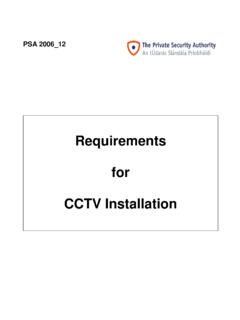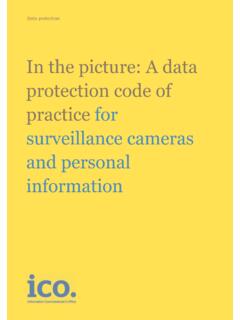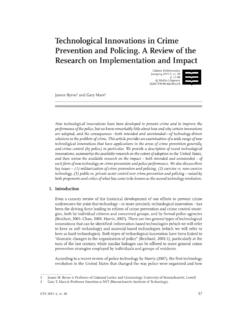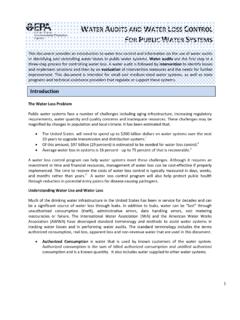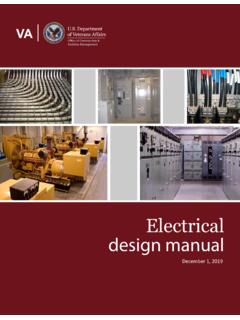Transcription of Unit 20: Communication and Technology in the Uniformed ...
1 unit 20: Communication and Technology in the Uniformed Public Services unit code: A/600/6098. QCF Level 3: BTEC National Credit value: 10. Guided learning hours: 60. Aim and purpose The aim of this unit is to develop learners' knowledge of the different forms of Communication , including radio, and types of Technology used in the Uniformed public services. This unit will enable learners to use the different types of Communication systems and develop their skills in the use of radio procedures. unit introduction This unit introduces learners to the equipment and skills used to communicate within the Uniformed public services. The content of the unit will enable learners to develop and practise skills that will be of value in the context of Uniformed public service work and further study. The unit will include specific formalised written Communication used in this specialist area of work.
2 Learners will explore the different forms of Communication transmission and radio Communication and will practise using the techniques developed throughout the unit . Learners will learn and practise using the phonetic alphabet, semaphore and Morse code. This will give them an understanding of covert or coded Communication as well as a background to the more sophisticated encrypted Communication used in the Uniformed public services today. Learners will explore the different types of technological systems used to improve the effectiveness of the Uniformed public services. Learners will consider the different types of equipment used by the Uniformed public services and the benefits gained through using this equipment. Learning outcomes On completion of this unit a learner should: 1 Know types of formal written Communication used in the public services 2 Be able to use the radio procedure of a Uniformed public service 3 Be able to use different types of Communication systems 4 Know the different types of technological systems used by the Uniformed public services.
3 Edexcel BTEC Level 3 Nationals specification in Public Services Issue 2 October 2011 Pearson Education Limited 2011. 1. unit content 1 Know types of formal written Communication used in the public services Formal written communications: letters; memos; reports, incident reports, annual reports, HM Inspection reports, audit reports; internet; intranet; email; other written Communication , journals, prison service instructions (PSIs), prison service orders (PSOs), staff notices, standard operation procedures, brigade bulletins 2 Be able to use the radio procedure of a Uniformed public service Radios: eg Pye, Racal, Clansman, Bowman, Airwave, Personal Role Radio (PRR), Ptarmigan; Ultra-High Frequency (UHF), Very-High Frequency (VHF), High Frequency (HF). Use of radio procedures in the Uniformed public services: police, army, RAF, Royal Navy, HM Coastguard, HM Revenue & Customs Radio Communication : voice procedures; security; accuracy and discipline; prowords; call signs; code words; phonetic alphabet; authentication; net control; rebroadcast; radio users; pass simple messages.
4 Leaving and joining the net; test call; urgent messages; battle orders; weather forecasts 3 Be able to use different types of Communication systems Communication systems: reasons for use; origins of each type of Communication ; relevance to specific Uniformed public services; practical use of different types of Communication ; object video; lingua net;. microwave; Bluetooth . Standard voice procedures: used in the Uniformed public services eg army, police, ambulance Satellite communications (SATCOM): video link; internet telephone; email; Morse code; wireless networking; mobile phone; internet; paging; semaphore 4 Know the different types of technological systems used by the Uniformed public services Equipment: electronic tagging, cctv , passive Radio Frequency (RF) sensors, x-ray machines, geophone, satellite navigation, vehicle mounted data systems, thermal imaging cameras, automatic distress signal unit , roaming network mobile phone, simulators, fax machine, handheld metal detectors, nuclear quadruple resonances sensors, man-portable surveillance and target acquisition radar (MSTAR), Intelligence, Surveillance, Target Acquisition and Reconnaissance (ISTAR) equipment Importance of using different types of technological systems: effective Communication ; rapid response.
5 Collaboration between services; advantages and disadvantages; inter-agency Communication eg firelink project Use of technological systems in the Uniformed public services: police, ambulance, fire, army, navy, RAF, coastguard Edexcel BTEC Level 3 Nationals specification in Public Services 2 Issue 2 October 2011 Pearson Education Limited 2011. Assessment and grading criteria In order to pass this unit , the evidence that the learner presents for assessment needs to demonstrate that they can meet all the learning outcomes for the unit . The assessment criteria for a pass grade describe the level of achievement required to pass this unit . Assessment and grading criteria To achieve a pass grade the To achieve a merit grade the To achieve a distinction grade evidence must show that the evidence must show that, in the evidence must show that, learner is able to: addition to the pass criteria, in addition to the pass and the learner is able to: merit criteria, the learner is able to.
6 P1 describe different types of formal written Communication used in the Uniformed public services P2 send a message by radio M1 compare different types of using standard voice radio Communication systems procedures from one Uniformed public service P3 send a message using M2 analyse the advantages and different forms of disadvantages of different Communication Communication systems P4 describe different types of M3 explain in detail the benefits D1 evaluate the importance of technological equipment of using technological using Communication and used by a selected Uniformed equipment in a selected technological equipment public service. [IE] Uniformed public service. in the daily operation of Uniformed public services. PLTS: This summary references where applicable, in the square brackets, the elements of the personal, learning and thinking skills applicable in the pass criteria.
7 It identifies opportunities for learners to demonstrate effective application of the referenced elements of the skills. Key IE independent enquirers RL reflective learners SM self-managers CT creative thinkers TW team workers EP effective participators Edexcel BTEC Level 3 Nationals specification in Public Services Issue 2 October 2011 Pearson Education Limited 2011. 3. Essential guidance for tutors Delivery This unit should be practically based and should encourage personal research and contact with various Uniformed public services. This can be done through visits or visiting speakers from appropriate organisations. Tutors should enable learners to practise and develop appropriate skills. Ideally, staff should have some understanding or background in communications in at least one of the Uniformed public services but, if not, they can contact any of these services (for example fire service control room, police service headquarters control room, army communications system or ambulance service) for input.
8 Learners need to understand the various methods that public service organisations use to communicate with both their employees and their customers, for example intranet, staff information notices, memoranda, official orders such as prison service instructions or prison service orders. Most public services show the links to their formal communications on their website. Learners need to gain an understanding of the layout of formal letters or reports used within the Uniformed public services. Authentic paperwork to support this activity would be useful. Many types of radio Communication systems are used throughout the public services. It may benefit learners to visit a control room or to observe radios in operation at a local territorial army (TA) centre. Learners are required to use radio and voice procedure to send and receive messages. The tutor should explain radio and voice procedures used by the Uniformed public services.
9 Tutors could arrange a visit to any public service so that learners can see the different types of equipment in use and maybe use it themselves. Most fire stations are accommodating when it comes to showing members of the public the new Technology being used for life-saving purposes. Videos from the Royal Corps of Signals and the Royal Air Force may help to support the delivery of this unit . Outline learning plan The outline learning plan has been included in this unit as guidance and can be used in conjunction with the programme of suggested assignments. The outline learning plan demonstrates one way in planning the delivery and assessment of this unit . Topic and suggested assignments/activities and/assessment Introduction to unit and outline of assessment. Formal written Communication theory and reasons for use. Formal written Communication practice worksheets.
10 Assignment 1: Formal Written Communication (P1). Tutor introduces the assignment brief. Theory input. Demonstration of the different types of radio. Voice procedures. Phonetic alphabet and sending of messages. Guest speakers use of technological systems in the Uniformed public services Other Communication systems theory. Edexcel BTEC Level 3 Nationals specification in Public Services 4 Issue 2 October 2011 Pearson Education Limited 2011. Topic and suggested assignments/activities and/assessment Other Communication systems practicals. Assignment 2: Sending my Messages (P2, P3, M1, M2). Tutor introduces the assignment brief. Technology in the Uniformed public services. Guest speakers/visits. Types of Technology . Importance of Technology theory. Demonstration of different types of technological systems. Visit to technological Communication company/organisations.










